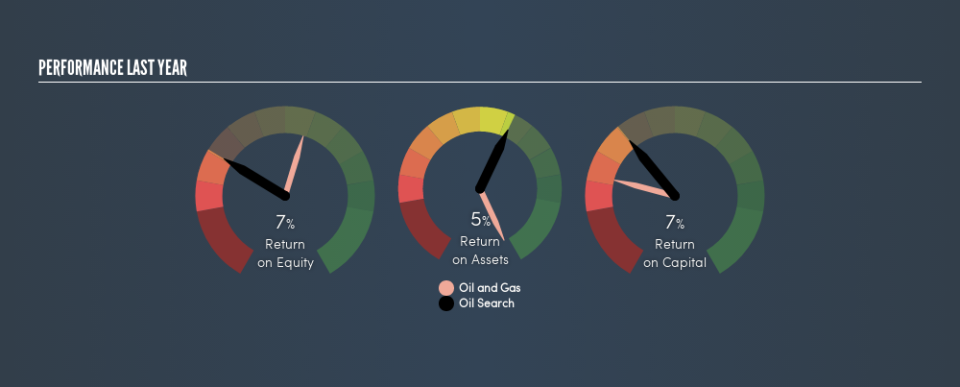Why Oil Search Limited’s (ASX:OSH) Return On Capital Employed Might Be A Concern

Want to participate in a short research study? Help shape the future of investing tools and you could win a $250 gift card!
Today we are going to look at Oil Search Limited (ASX:OSH) to see whether it might be an attractive investment prospect. In particular, we'll consider its Return On Capital Employed (ROCE), as that can give us insight into how profitably the company is able to employ capital in its business.
First up, we'll look at what ROCE is and how we calculate it. Next, we'll compare it to others in its industry. Finally, we'll look at how its current liabilities affect its ROCE.
Return On Capital Employed (ROCE): What is it?
ROCE measures the 'return' (pre-tax profit) a company generates from capital employed in its business. In general, businesses with a higher ROCE are usually better quality. In brief, it is a useful tool, but it is not without drawbacks. Renowned investment researcher Michael Mauboussin has suggested that a high ROCE can indicate that 'one dollar invested in the company generates value of more than one dollar'.
So, How Do We Calculate ROCE?
The formula for calculating the return on capital employed is:
Return on Capital Employed = Earnings Before Interest and Tax (EBIT) ÷ (Total Assets - Current Liabilities)
Or for Oil Search:
0.073 = US$721m ÷ (US$11b - US$771m) (Based on the trailing twelve months to December 2018.)
So, Oil Search has an ROCE of 7.3%.
See our latest analysis for Oil Search
Does Oil Search Have A Good ROCE?
When making comparisons between similar businesses, investors may find ROCE useful. Using our data, Oil Search's ROCE appears to be significantly below the 10% average in the Oil and Gas industry. This performance could be negative if sustained, as it suggests the business may underperform its industry. Separate from how Oil Search stacks up against its industry, its ROCE in absolute terms is mediocre; relative to the returns on government bonds. It is possible that there are more rewarding investments out there.
Our data shows that Oil Search currently has an ROCE of 7.3%, compared to its ROCE of 3.0% 3 years ago. This makes us think the business might be improving. You can click on the image below to see (in greater detail) how Oil Search's past growth compares to other companies.
Remember that this metric is backwards looking - it shows what has happened in the past, and does not accurately predict the future. Companies in cyclical industries can be difficult to understand using ROCE, as returns typically look high during boom times, and low during busts. ROCE is only a point-in-time measure. Given the industry it operates in, Oil Search could be considered cyclical. Since the future is so important for investors, you should check out our free report on analyst forecasts for Oil Search.
How Oil Search's Current Liabilities Impact Its ROCE
Current liabilities include invoices, such as supplier payments, short-term debt, or a tax bill, that need to be paid within 12 months. The ROCE equation subtracts current liabilities from capital employed, so a company with a lot of current liabilities appears to have less capital employed, and a higher ROCE than otherwise. To counteract this, we check if a company has high current liabilities, relative to its total assets.
Oil Search has total liabilities of US$771m and total assets of US$11b. Therefore its current liabilities are equivalent to approximately 7.2% of its total assets. With low levels of current liabilities, at least Oil Search's mediocre ROCE is not unduly boosted.
The Bottom Line On Oil Search's ROCE
Based on this information, Oil Search appears to be a mediocre business. You might be able to find a better investment than Oil Search. If you want a selection of possible winners, check out this free list of interesting companies that trade on a P/E below 20 (but have proven they can grow earnings).
I will like Oil Search better if I see some big insider buys. While we wait, check out this free list of growing companies with considerable, recent, insider buying.
We aim to bring you long-term focused research analysis driven by fundamental data. Note that our analysis may not factor in the latest price-sensitive company announcements or qualitative material.
If you spot an error that warrants correction, please contact the editor at editorial-team@simplywallst.com. This article by Simply Wall St is general in nature. It does not constitute a recommendation to buy or sell any stock, and does not take account of your objectives, or your financial situation. Simply Wall St has no position in the stocks mentioned. Thank you for reading.

 Yahoo Finance
Yahoo Finance 
